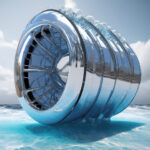New Boron Nitride Quantum Sensors Measure Stress and Magnetism Under 30,000× Pressure
The world of quantum physics is mysterious. But what happens when that realm of subatomic particles collides with the tangible world of pressure and stress? A groundbreaking innovation has emerged in the form of boron nitride quantum sensors that can measure stress and magnetism under pressures exceeding 30,000 times that of Earth’s atmosphere.
Quantum sensors are revolutionizing various fields, from healthcare to environmental monitoring. These sensors, utilizing the principles of quantum mechanics, have shown exceptional sensitivity and precision in detecting and measuring various factors. However, the application of quantum sensors under extreme conditions, such as high pressures, has been a significant challenge until now.
Boron nitride, a compound known for its exceptional mechanical and thermal properties, has taken center stage in the development of these quantum sensors. By leveraging the unique characteristics of boron nitride at the atomic level, scientists have been able to create sensors that can withstand immense pressures while maintaining their sensitivity and accuracy.
One of the most intriguing capabilities of these boron nitride quantum sensors is their ability to measure stress. Under high-pressure conditions, materials exhibit different mechanical behaviors that can provide valuable insights into their properties. The sensors can detect minuscule changes in stress levels, allowing researchers to study the behavior of materials under extreme pressure with unprecedented detail.
Moreover, the sensors can also measure magnetism under high pressures, offering a new perspective on magnetic materials’ behavior in challenging environments. This capability opens up possibilities for studying magnetic phenomena in conditions that were previously inaccessible, paving the way for advancements in fields such as magnetic storage, quantum computing, and materials science.
The implications of this innovation are vast. In materials science, researchers can now explore the mechanical and magnetic properties of substances under extreme pressures with a level of precision that was once unimaginable. This deeper understanding can lead to the development of novel materials with tailored properties for specific applications.
Furthermore, the applications extend beyond the laboratory. Industries such as aerospace, automotive, and manufacturing can benefit from the insights provided by boron nitride quantum sensors. Understanding how materials behave under high pressures can lead to the development of more durable and efficient products, ultimately enhancing performance and safety.
In conclusion, the development of boron nitride quantum sensors marks a significant milestone in the integration of quantum physics into real-world applications. By enabling the measurement of stress and magnetism under extreme pressures, these sensors open doors to new possibilities in research, industry, and technology. As we continue to push the boundaries of scientific exploration, innovations like these remind us of the endless potential that lies at the intersection of quantum mechanics and everyday life.
boron nitride, quantum sensors, stress measurement, magnetism, high pressure environments










